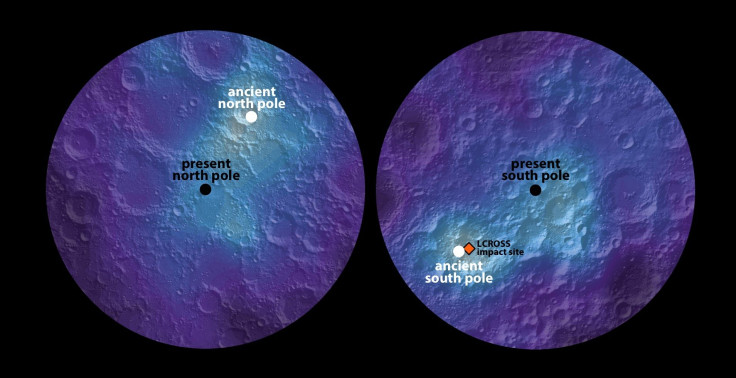Moon's Tilt Was Changed By Volcanic Activity Over 3 Billion Years Ago, Study Reveals

Our moon has had a wobbly past, a new study has revealed. According to a paper published Wednesday in the journal Nature, until about 3 billion years ago, the moon used to spin on a different axis, showing a slightly different face to the Earth.
“The same face of the moon has not always pointed towards Earth,” lead author Matthew Siegler from the Planetary Science Institute in Tucson, Arizona, said in a statement. “As the axis moved, so did the face of the ‘man in the moon.’ He sort of turned his nose up at the Earth.”
The study was based on data collected by several NASA missions, including the Lunar Prospector, Lunar Reconnaissance Orbiter, Lunar Crater and Observation Sensing Satellite, and the Gravity Recovery and Interior Laboratory. Analysis of the data revealed an interesting discrepancy, which, upon further examination, led scientists to conclude that our sole natural satellite may have undergone a radical change in its ancient past.
Scientists first suspected that the moon had deposits of water-ice back way back in the late 1990s, after hydrogen was first discovered on the lunar surface by the Lunar Prospector probe. The existence of water-ice was inferred by the presence of these hydrogen deposits — because water is rich in hydrogen — which indicated that ice was lurking inside craters at the lunar poles in areas that are perpetually engulfed in shadows.
However, while poring over the data about these regions, Siegler discovered that water-ice was missing from some of the shadowed regions. This suggested that some of the craters may have been exposed to sunlight sometime in the past, causing the water-ice to evaporate.
The researchers also found that the ice that had survived this shift effectively painted a path along which the axis moved. They matched the path with models predicting where the ice could remain stable and inferred that the moon’s axis had moved by approximately five degrees.
So what could have caused the lunar poles to wander?
A likely explanation for this shift, which took place over several million years, is volcanic activity in the Procellarum — a region on the nearside of the moon.

Since a planet’s, or a moon’s, axis is determined by its relative mass, a shift in mass would bring about changes in its axis. The researchers estimate that volcanic activity melted some of the moon's mantle about 3.5 billion years ago, creating a giant, hot blob that was lighter than the colder rock around it. As the magma moved around, the mass redistribution slowly shifted the moon’s axis.
“The new findings are a compelling view of the moon’s dynamic past,” Yvonne Pendleton, director of NASA’s Solar System Exploration Research Virtual Institute, said in the statement. “It is wonderful to see the results of several missions pointing to these insights.”
© Copyright IBTimes 2024. All rights reserved.






















